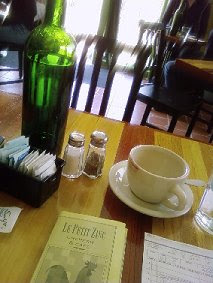 Memorial Weekend traditionally marks the beginning of the gardening season in this part of the country, the earliest date that one can be reasonably confident not to encounter a devastating frost immediately upon dropping that last tomato plant into a hand-hewn hole in the ground. I started making preparations a few days ahead of time this year, beginning by locating the window box that I'd brought over from my previous address. I'll admit that last fall's wedding activities snatched the majority of the attention that I had been paying to my plants away mid-stream. Accordingly, I expected to find the badly neglected window box, which had been overgrown with unruly oregano and mint in October, exactly where I had left it, and full of...dirt. So, imagine my surprise when I rounded the corner of the house to find the window box, yes, just where I had left it, but also brimming with a purple-tinged dark green forest of herbs. I had underestimated my mint! Twenty minutes later, I had a relatively debris-free mint planter, and a head start on my garden for the year.
Memorial Weekend traditionally marks the beginning of the gardening season in this part of the country, the earliest date that one can be reasonably confident not to encounter a devastating frost immediately upon dropping that last tomato plant into a hand-hewn hole in the ground. I started making preparations a few days ahead of time this year, beginning by locating the window box that I'd brought over from my previous address. I'll admit that last fall's wedding activities snatched the majority of the attention that I had been paying to my plants away mid-stream. Accordingly, I expected to find the badly neglected window box, which had been overgrown with unruly oregano and mint in October, exactly where I had left it, and full of...dirt. So, imagine my surprise when I rounded the corner of the house to find the window box, yes, just where I had left it, but also brimming with a purple-tinged dark green forest of herbs. I had underestimated my mint! Twenty minutes later, I had a relatively debris-free mint planter, and a head start on my garden for the year.Tonight, I was thrilled to take advantage of my windfall for the first time, using my home grown mint in Pea and Parmesan Wonton Ravioli, from the May issue of Gourmet magazine. Since there were only two of us for dinner, and this recipe yields quite a bit, I cut the portions down by a quarter, and it still worked beautifully. In fact, after assembling the ravioli, I realized that I had come up with exactly 24 ravioli without even trying - precisely three-quarters of the stated yield! We had enough for dinner for two, with plenty left over.
I have to say that this recipe really delivers in terms of time, and taste. The bright peas and fresh mint in these ravioli positively scream of spring, and the parmesan adds a wonderfully savory and filling aspect to the vegetarian dish. All of that in five ingredients and under an hour? I'm sold. With one of those five ingredients conveniently growing in my backyard, I'll keep the rest on hand to make this recipe in a pinch.
The recipe for Pea and Parmesan Wonton Ravioli can be found at Epicurious.com. One note of warning: Allow wonton wrappers to remain too wet after cooking, and they will be slimy. Too dry? The ravioli will stick together. Be sure to lay the ravioli out flat after they are removed from the water, and consider allowing both sides to dry quickly before serving.











